50 reasons to celebrate anniversary weekend 2016
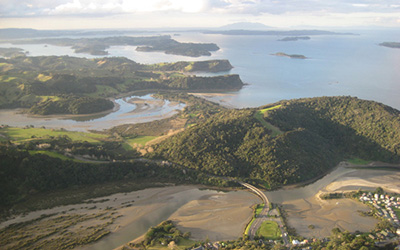
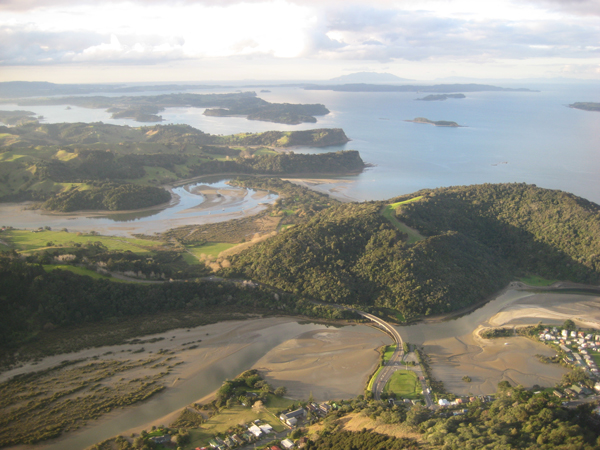
Start of the Coastal Regional Parks: First was Wenderholm, in 1965. Then, within five years, the entire coastline between Waiwera, foreground, and into the Mahurangi Harbour three headlands to Ōpahi was saved from urban development, and safely in the public domain. image ImageShack
First reason: It will be the 50th summer of Auckland’s coastal regional parks.
The coastal parks commenced with the purchase of Wenderholm Regional Park on 31 March 1965, and its opening the following December. It was an immediate success as Aucklanders poured into the park throughout the summer of 1965–1966. Neighbouring Waiwera felt the impact immediately. Up until that summer, patronage at Waiwera’s mineral pools had been doubling year on year. With the opening of Wenderholm, the 250 000 people per year queuing to swim in hot and warm water pools, on even the most sultry of summer days, had an alternate destination, without a 30-kilometre-farther drive north to the next publicly accessible swimming beach.
Wenderholm’s setting with its alluring swimming beach, beguiling estuary, towering forested bluff were such that Queen Elizabeth II was provided an afternoon retreat there, during her 1953 tour. If Wenderholm had been the only coastal regional park ever purchased, its acquisition would still warrant major celebration, 50 years on. While, legitimately, the 50th anniversary of the purchase could be celebrated in March 2015, Aucklanders’ love affair with their coastal regional parks began the following summer, when, driven hard to do so by the first chairman of regional parks, Judge Arnold R Turner, Wenderholm was promptly opened to the public.
The vision for establishing a network of coastal regional parks was that of Frederick W O Jones. In 1946 F W O ‘Fow’ Jones became the region’s first metropolitan planner. He soon identified an urgent need to create ‘metropolitan beach reserves’:
…many of our better beaches, particularly the eastern ones just north of Auckland, are rapidly becoming lost to the population…
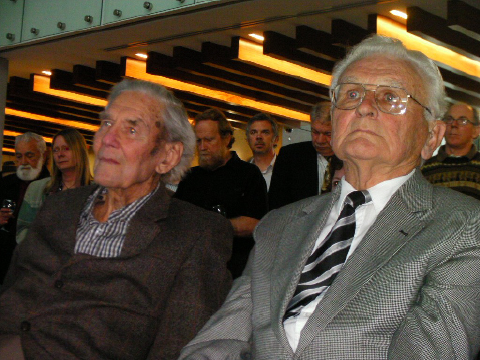
A Yet More Dangerous Man: Arnold Turner CMG, right, kindly ‘corrected’ Jade River : A History of the Mahurangi, which credits Jim Holdaway CNZM OBE DFC (bar), left, with being the first chairman of the Auckland Regional Authority’s parks committee, and, by inference, with being the instigator of the regional parks. Aside from the fact that Turner preceded Holdaway as parks chairman, Justice Turner assiduously credits the first region-wide planner, Frederick W O Jones, for the vision to purchase land for the region’s coastal parks. image mikelee.co.nz
However, the organisation that employed Jones was advisory only and although extant legislation would have permitted central and local government to act in concert to purchase coastal parks on behalf on the region, Jones failed to get traction. When the land between the main road and the northern section of Ōrewa beach went on sale for £10 000, he urged the Crown to purchase it. The inflation-adjusted price tag of $1 million or so, today, wouldn’t buy an apartment on the Ōrewa beachfront.
Jones’ luck, and that of future Aucklanders, changed dramatically once Arnold Turner joined the regional planning body. Justice Turner, now Arnold Turner CMG, drafted the regional parks empowering clauses that became part of the legislation establishing the Auckland Regional Authority—now planning for regional parks had teeth. With Wenderholm purchased, Long Bay and Shakespear coastal regional parks swiftly followed, magnificently vindicating Frederick Jones’ vision. Since then, the number of regional parks has risen to 26, including those acquired historically, the oldest purchase being the core of Muriwai Regional Park, in 1890. Aucklanders regularly rate the network as the regional facility they most highly value.
Short of their centennial, 50 years of coastal regional parks certainly deserves celebrating. The only valid questions are when, and in what form the celebrations should take. The region is fortunate in having its anniversary weekend in midsummer. It is the single biggest three-day period for the parks, possibly because fewer Aucklanders decamp the region that weekend than do so during the Christmas–summer holidays. Meantime, the month of the actual opening of Wenderholm, December, for most people tends to be a frenetic time of the year when many would be hard-pressed to take time out for the parks’ fiftieth. Besides, it was the summer that Wenderholm was opened that was made so memorable, rather than the month of December.
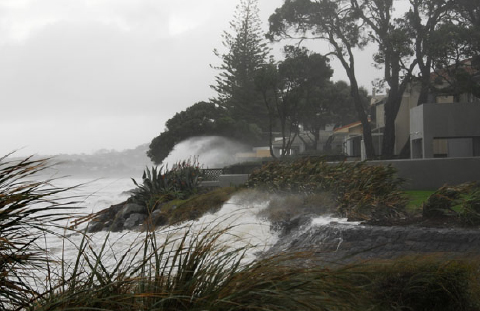
Again Will Go for a Song: The equivalent of $1 million or so in today’s money that the government baulked at paying for the northern half of the Ōrewa beachfront, by mid this century, would be too much to pay for all waterfront apartments on it when, sooner or later, it is hit by a king tide – storm surge combination the likes of which submerged the southbound lanes of the Northern Motorway on 23 January 2011. image Rodney Times
But there’s an additional reason to favour Auckland Anniversary weekend as the date to celebrate the parks. Although the weekend has always had an iconic event, the Auckland Anniversary Regatta, the regatta is not for everyone. But if the regional parks are added to the equation, the percentage of Aucklanders participating rises convincingly. And some regional parks are already tightly involved in the regatta, given that the event, since the revival of the Mahurangi Regatta in 1977, has become a three-day affair. The Mahurangi Regatta neatly bookends Auckland Anniversary weekend, with the evening race to Mahurangi beginning on the Friday afternoon, and the Mahurangi Regatta proper on the Saturday. On the day, many times more people picnic in the regional park at Sullivans Bay to watch it than sail in the regatta, and there are the perennial running and novelty beach events that capture generation after generation of children and grandparents.
If every regional park, each in its own unique way, was to celebrate Auckland Anniversary every year, the weekend would be on its way to being a celebration of the region, rather than just another three-day weekend. This brings in yet another reason for the 50th celebrations. Traditionally, Auckland Anniversary weekend was the last hurrah for those privileged to have coastal boltholes. It was once an almost egalitarian institution; cheap and cheerful baches could be owned on Whangaparāoa, or an even cheaper and more cheerful caravan or tent sites rented at Ōrewa. But with coastal urban sprawl, ruinous rents and mortgages, and a now yawning gap between a wealthy minority and the rest, the percentage owning vacation homes is much reduced. With a rich programme of anniversary weekend events, citizens obliged to make the best of it without leaving the region would have more time to enjoy themselves than those sitting in queues of cars, churning out the greenhouse gases. Aucklanders camping in sublime settings such as Te Muri, at $6 per night, would be the real winners. In short, Auckland Anniversary is perfectly poised to become the weekend to visit the region, rather than be reason to flee it.
The obvious major new event required is one on Auckland’s waterfront on the Monday, with a backdrop of the largest one-day regatta in the world. Sailing may be a minority sport, but on the Waitematā it is a large minority and one that enjoys majority support in the form of spectators, recently thanks to the America’s Cup. Queens Wharf could host a regatta picnic with world-class musicians and spectacular prize-giving dance in the evening. Top chefs could judge the picnic hampers, with prizes including for ‘best bloke-built’ and ‘best junior-built’ picnic. America’s Cup catamarans would provide a sure-fire draw card. By running free sailing schools on the Sunday, off as many coastal park beaches as the weather permitted, future generations of fanatical young sailors would be assured.
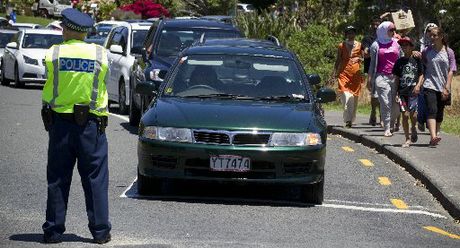
Car Parks: Policing one-in-one-out at Long Bay, New Year’s Day 2013. Provision for the ‘informal’ parking of cars was an express wish of parks visionary Frederick Jones 1911–2002. But while that was an entirely reasonable proposition in the 1950s, post the awareness of the need to drastically reduce fossil fuel use, public transport must take precedence over car parking. Special buses to the regional parks should, by now, be running every summer weekend and holiday. photographer Greg Bowker
The key to weaving together a wondrous weekend is free public transport. Those who availed themselves of it would find that it leavened the outing like no other factor. Auckland’s downtown, car-free for three days, would be a revelation. And, as an antidote to the behaviour of unrepentant bullies who delight in lording it over service workers, the weekend could be a celebration of the bus and train drivers, the baristas, park rangers and volunteers, working through the weekend. Patrons might even be encouraged to donate to charities of the worker’s choice—giving is guaranteed to burnish the holiday glow. And to champion better regional park access by public transport, the proposed Mahurangi Coastal Trail could be opened as part of the main celebrations at Wenderholm, in 2016.
In the week preceding the celebratory weekend, Aucklanders could host the first international regional parks conference—a title suggested being: Regional Parks – The Next 50 Years. Regional parks are facing fundamental changes, forced by anthropogenic global warming. When Frederick Jones first conceived his beach reserves, he emphasised the need to provide for limitless informal car parking. He particularly stressed the informal—being able to wheel in the family car and park it in a favoured spot was clearly integral to how Aucklanders would enjoy their coastal parks. But, in the 2010s, there is no excuse for continuing to favour the car over public transport, and by 2066 the beaches of the coastal regional parks will be under heavy assault. Sandspits such as at Wenderholm and Te Muri need to be rendered more resilient to ensure that their dune systems survive as long as possible. Heritage buildings such as Couldrey House and Scott Homestead will need to be relocated—a heritage measure of last resort. While it counterintuitive, the state must purchase more land at sea level for public purposes, rather than less, to allow its transition to be managed, and for public access to be maintained. Without such planning, much of the coastline will become the private battleground of property holders and the rising sea.
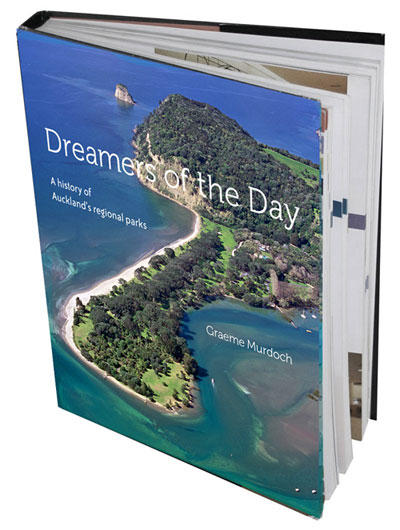
That and Te Muri: Two brilliant achievements were pulled off in 2010, in the last days of the Auckland Regional Council. The more expensive, at $15 million for 407 hectares, was the purchase of the balance of the Schischka farm at Te Muri. The positively affordable, at $60 for 344 pages, was the commissioning of a history of Auckland’s regional parks. image Auckland Regional Council
Although that makes only about 25 reasons for regarding Auckland Anniversary weekend 2016 as a major event, 50 summers of regional parks is ample excuse for a celebration.
Aucklanders have one chance to do justice to the regional parks’ dreamers of the day.
Footnote The title of Graeme Murdoch’s marvellous marathon history of Makaurau’s regional parks, Dreamers of the Day, comes from T E Lawrence’s Seven Pillars of Wisdom:
All men dream: but not equally. Those who dream in the dark recesses of the night awake in the day to find all was vanity. But the dreamers of day are dangerous men, for they may act their dreams with open eyes, and make it possible.
